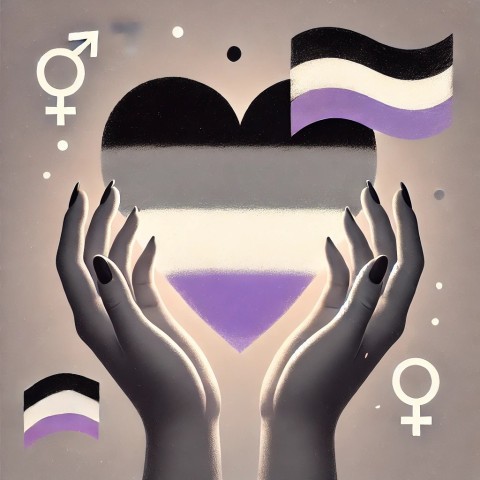Understanding asexuality is crucial for anyone involved in the complex world of human sexuality, including escorts, their clients, and the general public. Asexuality is often misunderstood, overlooked, or outright dismissed in discussions about sexual orientation and desire. Many people believe that everyone experiences sexual attraction, but this assumption is far from true. Asexuality is a legitimate and natural variation of human experience, characterized by a lack of sexual attraction to others. However, being asexual doesn’t mean that someone is devoid of intimacy, romance, or meaningful relationships. Understanding what asexuality truly is, and dispelling the myths surrounding it, is essential for creating a more inclusive and empathetic approach to sexuality, both in personal interactions and in the professional realms like the escort industry.
One of the most pervasive myths about asexuality is that it’s just another form of celibacy or that asexual individuals are simply choosing not to engage in sexual activities. While celibacy is a choice to abstain from sexual activity, often for personal, religious, or philosophical reasons, asexuality is an inherent orientation. It’s not about choosing not to have sex but rather about not experiencing sexual attraction in the first place. This distinction is important because it shifts the focus from behavior to orientation. Asexual people might still engage in sexual activities for various reasons such as out of curiosity, to please a partner, or because they enjoy the physical sensations but these actions do not stem from sexual attraction. Understanding this can help escorts and clients alike better navigate conversations about boundaries, preferences, and comfort levels.
Another common misconception is that asexual individuals are incapable of love or desire, or that they lack the ability to form deep, meaningful relationships. This could not be further from the truth. Asexuality only refers to the lack of sexual attraction, not the absence of romantic attraction or the desire for companionship and intimacy. Many asexual people identify as romantic, which means they experience romantic attraction even though they don’t feel sexually drawn to others. These individuals might seek out relationships that are based on emotional intimacy, shared experiences, and mutual respect rather than sexual compatibility. For escorts working with a diverse clientele, recognizing the difference between romantic and sexual attraction is crucial in providing a respectful and empathetic service that meets the client’s needs, whether those needs are emotional, social, or physical.
There is also a widespread belief that asexuality is a result of trauma, a hormonal imbalance, or a psychological disorder. While it’s true that some people may experience a reduced interest in sex due to these factors, asexuality itself is not something that needs to be “fixed” or “cured.” It is simply one of many ways in which human beings experience and express their sexuality. Many asexual individuals are perfectly healthy, both physically and mentally, and their lack of sexual attraction is not a symptom of an underlying issue but rather a fundamental aspect of who they are. Escorts and their clients should approach conversations about asexuality with this understanding in mind, avoiding assumptions that a client’s orientation or preferences are a problem to be solved.
Another important aspect to consider is that asexuality exists on a spectrum. Not all asexual people experience their orientation in the same way. Some may identify as “graysexual,” which means they occasionally experience sexual attraction but only under specific circumstances or very infrequently. Others may identify as “demisexual,” meaning they only experience sexual attraction after forming a deep emotional connection with someone. This diversity within the asexual community highlights the complexity of human sexuality and the importance of avoiding blanket assumptions about what it means to be asexual. For those in the escort industry, understanding the nuances of the asexual spectrum can help in tailoring services and interactions to better suit the unique needs and preferences of each client.
It’s also essential to differentiate between sexual attraction, sexual desire, and sexual behavior. Sexual attraction refers to finding someone sexually appealing and wanting to engage in sexual activities with them. Sexual desire, or libido, is the physical or mental urge to engage in sexual activity, which doesn’t necessarily have to be directed at anyone in particular. Sexual behavior refers to the actions one takes to fulfill their sexual desires, whether with a partner or alone. Asexual individuals may still have a libido and engage in sexual behavior, such as masturbation, without feeling sexual attraction toward others. They may also have sexual relationships for reasons unrelated to their own attraction, such as to satisfy a partner or to experience intimacy in a way that aligns with their romantic feelings. This distinction is crucial for anyone trying to understand the asexual experience, as it shows that a lack of sexual attraction does not equate to a lack of desire or an inability to engage in sexual activities.
Another myth is that asexual people cannot enjoy or benefit from services offered by escorts. This is not true. Just like anyone else, asexual individuals can have a range of needs that an escort might be able to fulfill. These could include companionship, conversation, physical touch without the expectation of sexual activity, or even exploring their own sexuality in a safe and controlled environment. Escorts who are knowledgeable about asexuality and sensitive to the needs of asexual clients can provide a valuable service by offering a space where these clients feel respected and understood. This might involve providing more focus on non-sexual forms of intimacy, such as cuddling, talking, or shared experiences that don’t necessarily lead to sex.
It’s also worth noting that not all asexual people are sex-repulsed. Some are indifferent to sex, while others may even enjoy it under the right circumstances. Being aware of this variability is crucial for creating an environment where clients feel free to express their needs without fear of judgment or misunderstanding. An asexual client might request a session that involves some level of sexual activity but with clear boundaries and an understanding that their interest in the activity is not driven by sexual attraction. Respecting these boundaries and providing a service that aligns with the client’s comfort levels is key to building trust and ensuring a positive experience.
Another important consideration is how asexuality intersects with other aspects of identity, such as gender, sexual orientation, and cultural background. Asexual people can be of any gender or sexual orientation, and their experiences of asexuality can be influenced by these identities. For example, asexual men might face additional stigma due to societal expectations around male sexuality and the assumption that men are always eager for sex. Asexual women might experience pressure to conform to expectations of being sexually available or accommodating to male partners. Understanding these intersections can help escorts and their clients navigate the complexities of asexuality in a more nuanced and empathetic way.
In the broader societal context, asexuality is often marginalized or erased in discussions about sexuality and relationships. Many people, even those within the LGBTQ+ community, may not fully understand or accept asexuality as a legitimate orientation. This lack of visibility and understanding can lead to feelings of isolation or alienation for asexual individuals, who may struggle to find communities and resources that affirm their experiences. For escorts and their clients, being aware of this context can help foster a more inclusive and supportive environment where asexual people feel seen and validated.
For asexual individuals, navigating relationships can be particularly challenging. Traditional models of romantic and sexual relationships often assume that sexual attraction and activity are integral components. Asexual people may face pressure to conform to these norms or fear rejection if they disclose their orientation. This can make dating and relationships stressful and confusing, as they try to balance their own needs and boundaries with societal expectations and the desires of their partners. Escorts who are knowledgeable about asexuality can provide a unique form of support in this area, offering companionship and intimacy that respects the client’s boundaries and provides a safe space to explore their desires and preferences without the pressure of conventional romantic or sexual expectations.
For romantic partners of asexual individuals, understanding and accepting their partner’s orientation can be challenging but ultimately rewarding. It requires open communication, empathy, and a willingness to redefine what intimacy and connection mean within the relationship. Some couples might choose to have open relationships, where the sexual needs of the non-asexual partner are met outside the primary relationship, while others might find fulfillment in non-sexual forms of intimacy and connection. Escorts can play a role in these dynamics by providing a space where the non-asexual partner can explore their sexual desires without compromising the relationship’s core values of trust and mutual respect.
In conclusion, understanding asexuality requires moving beyond myths and stereotypes to appreciate the diversity and complexity of human sexual experience. Asexuality is a valid and natural orientation, characterized by a lack of sexual attraction to others, but this does not mean that asexual people are devoid of desire, intimacy, or meaningful relationships. By recognizing the nuances of asexuality and respecting the individual experiences of asexual clients, escorts can provide a service that is inclusive, empathetic, and truly supportive. Whether through offering companionship, non-sexual intimacy, or simply a respectful and understanding presence, escorts have the opportunity to meet the unique needs of asexual clients in ways that are both meaningful and empowering.
Creating a more inclusive and informed understanding of asexuality benefits everyone. It challenges the narrow definitions of sexuality that often dominate societal discourse and opens up new possibilities for connection, intimacy, and support. For escorts, clients, and the broader community, embracing the diversity of human sexual experience including the experiences of asexual individuals can lead to richer, more fulfilling interactions and relationships. It is only by truly understanding and respecting the full spectrum of human sexuality that we can create a world where everyone feels seen, valued, and understood.













